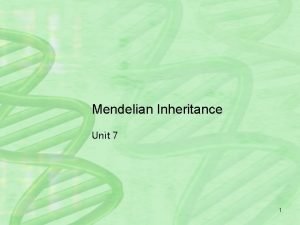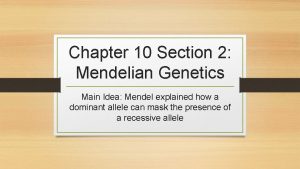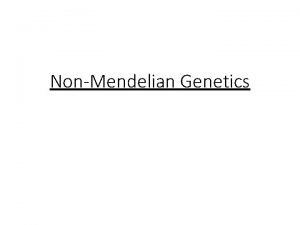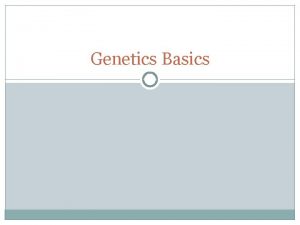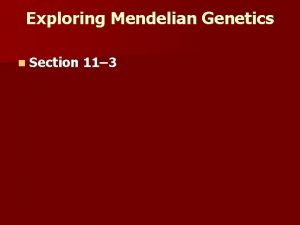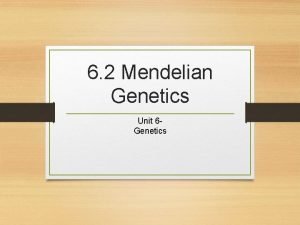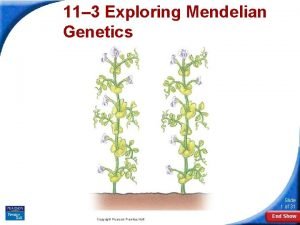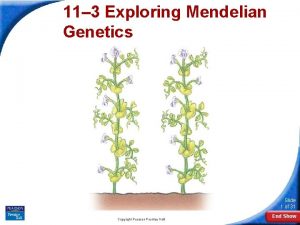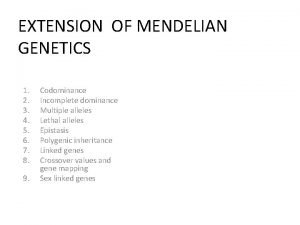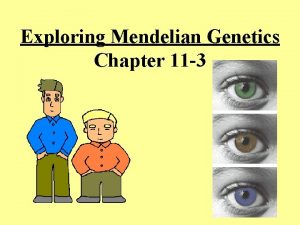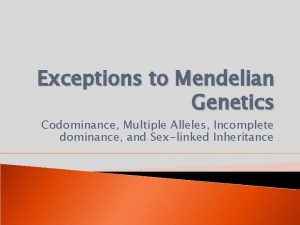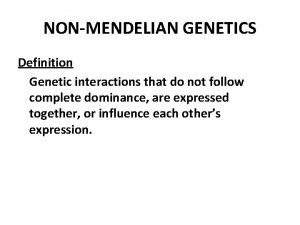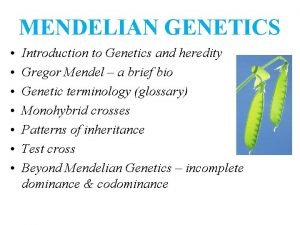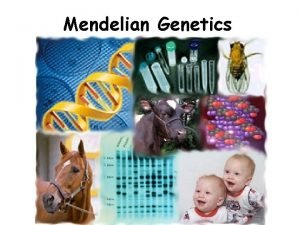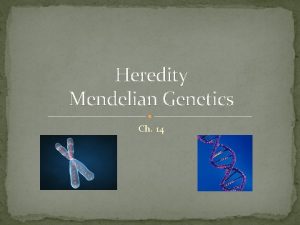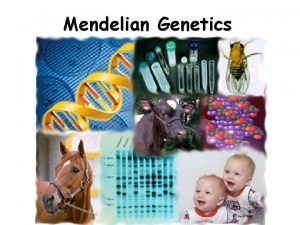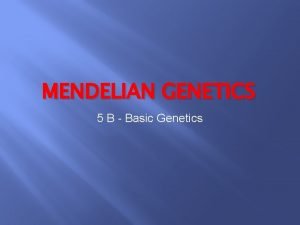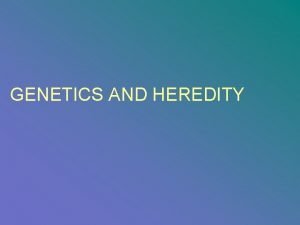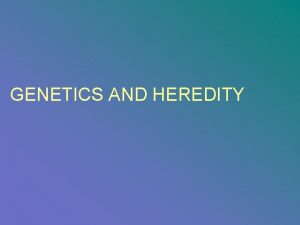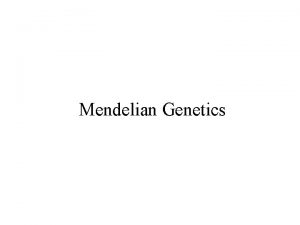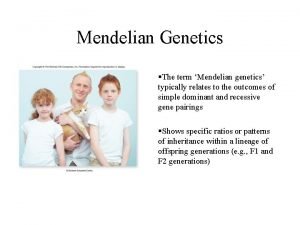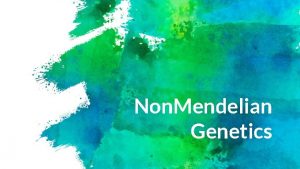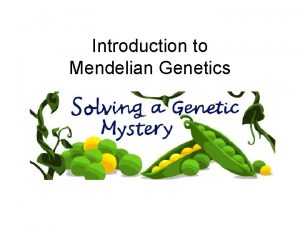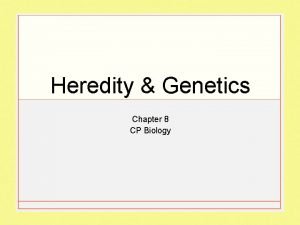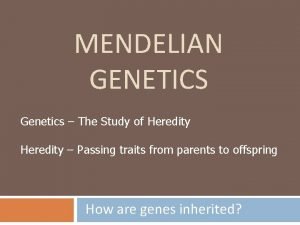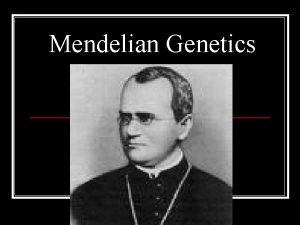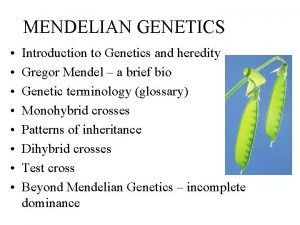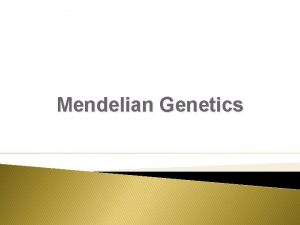Mendelian Heredity Fundamentals of Genetics Chapter 9 Heredity






















- Slides: 22


Mendelian Heredity (Fundamentals of Genetics) Chapter 9

Heredity The transmission of characteristics from parent to offspring. Trait (allele)- variant of a characteristic Mendel observed 7 characteristics of pea plants.

Characters vs. Traits

Mendel’s Methods Mendel observed traits by controlling how pea plants were pollinated. Pollination occurs when pollen grains (male) are transferred to the stigma (female. Normally, self-pollination occurs Mendel utilized cross-pollination, prevented selfpollination The offspring of a “cross” will have characteristics from both “parents” Hybrid

Manual Cross-Pollination

Mendel’s Experiments Used pea plants, easy to grow and quick to reproduce Began by growing true-breeding (purebred) plants Always produce offspring with that trait when they selfpollinate Cross-pollinated pairs of plants that were true-breeding for contrasting traits of a single characteristic Parents were P generation Offspring were F 1 generation F 1 offspring then self-pollinated F 2 generation


Mendel’s Laws of Heredity Each trait is controlled by a pair of factors (alleles) Dominant (Capital letter) Recessive (Lowercase letter) Law of Dominance - One factor (trait) in a pair may mask the effect of the other.


Mendel’s Laws of Heredity Each reproductive cell gets one factor (allele) of each pair When two gametes combine, the offspring has two factors for each characteristic Law of Segregation - The two traits for a characteristic separate during the formation of eggs and sperm.

Mendel’s Laws of Heredity Factors for individual characteristics are not connected (Anaphase I) Ex. Flower color vs. seed color (Green pods on a white plant) Law of Independent Assortment - The traits for different characteristics are distributed to reproductive cells independently.

Genotype and Phenotype Genotype- organism’s genetic makeup Ex. Genotype of a white-flowering plant consists of two recessive alleles for white color, pp. Ex. Genotype of a purple-flowering plant can either be PP or Pp. Phenotype- organism’s appearance Ex. Phenotype of a PP or Pp pea plant is purple flowers. Ex. Phenotype of a pp pea plant is white flowers.

Genetic Terms Homozygous- both alleles of a pair are alike Dominant PP Recessive pp Heterozygous- two alleles in the pair are different Heterozygous for flower color- Pp (Purple)

Using Punnett Squares Punnett Square Model that predicts the likely outcomes of a genetic cross with the alleles taken from the parents Shows all the genotypes that could result from a given cross

Monohybrid Cross A cross in which only one characteristic is tracked Contrasting traits (purple vs white flower) Homozygous Cross (PP or pp) Heterozygous Cross (Pp) Paternal alleles across the top Maternal alleles down the left side

Using Probability Likelihood that a specific event will occur Probability = # of one kind of possible outcomes total # of all possible outcomes Probability of a specific allele in a gamete Represented as a fraction or ratio

Punnett Square Practice 1. Homozygous x Homozygous 2. Homozygous x Herterozygous Cross between a pea plant homozygous for purple flower color (PP) and a pea plant homozygous for white flower (pp) Cross between a guinea pig that is homozygous dominant for the trait of black coat color (BB) and a guinea pig that is heterozygous for this trait (Bb) 3. Heterozygous x Heterozygous Cross between two rabbits that are heterozygous for coat color. In rabbits, the allele for black coat color (B) is dominant over the allele for brown coat color (b).

Many Genes, Many Alleles Polygenic Inheritance Example: Eye Color Several genes affect the characteristic Relative greenness or brownness, blue eyes are recessive Incomplete Dominance Intermediate between traits Example: Snapdragon (red and white = pink)

Many Genes, Many Alleles Codominance Both alleles for the same gene are fully expressed Example: Roan Shorthorn Cattle Multiple Alleles 3 or more possible alleles, only two alleles for a gene can be present Complex dominance Example: Blood types and Labrador coat color

Heredity & The Environment Genes can be affected by the environment Nutrients and temperature Personality and behavior

Uses for Heredity Pedigrees Several generations Determine genetic disorders or diseases that can be inherited Can answer questions about the three factors of inheritance Sex-linked genes Dominant or Recessive Heterozygous or Homozygous
 Family resemblance test
Family resemblance test Chapter 7 extending mendelian genetics answer key
Chapter 7 extending mendelian genetics answer key Chapter 10 section 2 mendelian genetics
Chapter 10 section 2 mendelian genetics Chapter 7 extending mendelian genetics vocabulary practice
Chapter 7 extending mendelian genetics vocabulary practice X linked recessive punnett square
X linked recessive punnett square Mendelian genetics vocabulary
Mendelian genetics vocabulary Chapter 17 lesson 2 heredity and genetics
Chapter 17 lesson 2 heredity and genetics Is baldness a sex linked trait
Is baldness a sex linked trait Section 11-3 exploring mendelian genetics answer key
Section 11-3 exploring mendelian genetics answer key What is heterozygous type b blood
What is heterozygous type b blood Section 11-3 exploring mendelian genetics
Section 11-3 exploring mendelian genetics Mendelian genetics punnett square
Mendelian genetics punnett square 11.3 exploring mendelian genetics
11.3 exploring mendelian genetics 11-3 exploring mendelian genetics answers
11-3 exploring mendelian genetics answers Holandric genes
Holandric genes Pprr x pprr punnett square
Pprr x pprr punnett square Section 11-3 exploring mendelian genetics
Section 11-3 exploring mendelian genetics Exceptions to mendelian genetics
Exceptions to mendelian genetics Phenotype simple definition
Phenotype simple definition Co doninance
Co doninance 3 laws of inheritance
3 laws of inheritance Mendelian genetics
Mendelian genetics What are mendelian traits
What are mendelian traits
